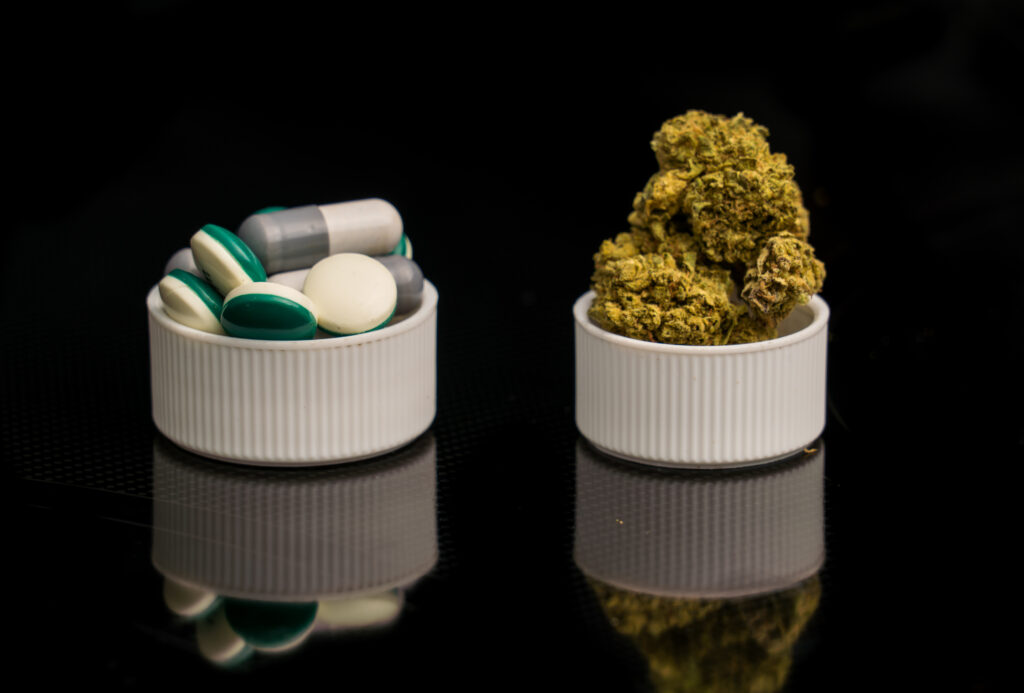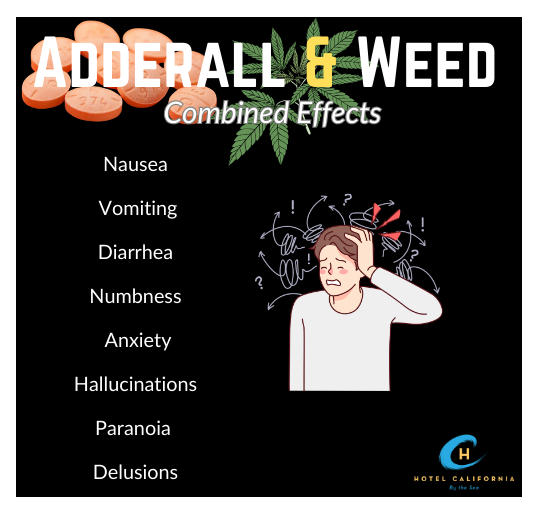Polysubstance Use: Adderall and Weed
There are over 40 million Adderall prescriptions users and an estimated 55 million marijuana users in the U.S. Both Adderall and weed are very popular and commonly used substances across the nation. It is not surprising they are also often used together. Adderall is a prescription stimulant drug used to help manage the symptoms of attention deficit hyperactivity disorder (ADHD) and symptoms of narcolepsy. Marijuana, cannabis or weed is a psychoactive substance that produces euphoric and depressant effects. The combination of using both substances can lead to unpredictable side effects and potentially dangerous risks of other health conditions.

Adderall is a Schedule II Controlled Substance while weed is a Schedule I Controlled Substance. One is a stimulant substance, while the other is a depressant substance. One is a commonly prescribed prescription medication while the other has mixed legal status varying from state to state without any federal regulations. However, both substances are often used recreationally and can lead to dependence, tolerance and addiction.
What is Adderall and how does it work?
Adderall is one of the most commonly prescribed medications used to treat symptoms of ADHD. The drug is comprised of dextroamphetamine saccharate, amphetamine aspartate, dextroamphetamine sulfate, and amphetamine sulfate. ADHD is a common neurobehavioral condition. It is a form of neurodiversity that reveals the differences in how the brain functions and causes drastic changes in levels of hyperactivity and impulsivity. It is most often diagnosed during childhood and can persist well into adulthood. An estimated 11% of school-aged children are diagnosed with ADHD and an estimated 4.4% of adults are also diagnosed with the condition.
The condition can become so intense that it can interfere with daily life functioning. According to the Diagnostic and Statistical Manual of Mental Disorders (DSM), there are a few types of ADHD conditions.
- Predominately inattentive. People who have this type of ADHD have difficulty regulating attention. They are easily distracted by noises and sights, have chronic boredom, are often forgetful, have trouble organizing, have trouble staying on task and are known to often lose their belongings.
- Predominately hyperactive/impulsive. People who have this type of ADHD are often restless, loud and engage in disruptive behaviors. They are known for their excessive talking, they have difficulty staying still, and constantly need to be in motion.
- ADHD-C. This type of condition is when a person has symptoms of both inattention and hyperactivity/impulsivity concurrently.
Adderall works by aiming to increase the levels of dopamine and norepinephrine in the brain to help promote heightened focus, concentration and wakefulness. This is because research suggests those with ADHD, produce too few neurochemicals in the brain. The drug boosts these neurotransmitters and can improve a person’s ability to concentrate and stay organized and enable them to have better control and management of their daily tasks and responsibilities.
Like other stimulant substances, Adderall does carry a risk of misuse or abuse which can lead to side effects such as headache, anxiety, insomnia, decreased appetite, cardiovascular complications, changes in mood, irritability, and psychological dependence. Other potential risks of Adderall use include heart attack, stroke, hallucinations, delusions, paranoia, cognitive impairment, sleep disturbances and withdrawal symptoms.

Marijuana, Cannabis and Weed
Marijuana, cannabis or weed is a depressant substance known for its sedative effects. It is a psychoactive substance that is most often smoked in blunts or vapes or consumed orally in edibles. The most common cannabinoids THC and CBD are the chemicals that can produce sedative and euphoric effects desired by users. THC is known for its analgesic properties, which makes it effective for some in helping to manage chronic pain conditions. Weed is often used as a form of self-medication to treat neuropathy, and arthritis as well as help to alleviate symptoms of anxiety and social anxiety.
Like other depressants and psychedelic substances, using weed can increase the risk of dependence and addiction and lead to side effects such as increased risk of lung infection, emphysema, cognitive impairment and worsening of mental health conditions like depression, anxiety or psychosis.
The effects of mixing Adderall and Weed
Mixing Adderall and weed can result in unpredictable effects. Adderall is a stimulant and weed is considered a depressant. When these substances with opposing effects are used together it can create adverse reactions to the body.
- Mixed reactions on anxiety – Adderall can heighten feelings of anxiety, while weed can suppress feelings of anxiety. When taken together, this can confuse the body and create feelings of paranoia.
- Increased heart rate – Both substances can elevate heart rate and lead to compounding effects on cardiovascular health.
- Increased risk of overdose of both substances. Weed can help suppress the stimulating effects of Adderall enough to the point where the user doesn’t notice the effects on the central nervous system and you can accidentally increase the dose of Adderall to dangerous levels.
- Increased risk of developing an addiction to either or both substances.
- Mixed reaction on appetite – Weed stimulates appetite, while Adderall suppresses appetite. When taken together, this can confuse the body canceling out one or the other.
- Cognitive impairment and motor functioning.
- Stimulating properties from Adderall can intensify the psychotropic effects of weed
- The sedative effects of weed can counteract the concentration enhancements and benefits of Adderall
- Diminished alertness and coordination
- Compounding psychotropic effects
- Exacerbation of the cardiovascular system
Check Your Insurance Coverage for FREE
Find out if your insurance covers addiction treatment in minutes. We accept most insurance!
Why do people participate in the polysubstance use of Adderall and Weed?
It’s no surprise people often mix Adderall and weed. They are some of the most popular substances often used for recreational purposes. Because each substance produces opposite effects, it is often used together in an attempt to balance out the side effects of each.
- Self-medication – self-management of symptoms of ADHD and anxiety
- Some use both substances because they seek relief from the challenges of daily life
- Some use both substances to enhance the recreational effects of both substances
- Some people use weed to activate the effects of Adderall to be able to enjoy the euphoric boost of energy and focus without anxiety or other nervous system reactions.
Signs that you may have an Addiction to Adderall or Weed
- You have difficulty stopping any drug use of Adderall or weed
- You increase drug dosage because you have become tolerant and need more in order to feel the desired effects
- You have cravings for Adderall or weed
- You are constantly thinking about ways to acquire more substances
- You prioritize the drugs over activities you once enjoyed
- You use the drugs in hazardous situations
- You continue to use the drugs despite its negative impact on your health and life
- You continue to use the drugs despite their negative impact on your relationships
- You neglect other responsibilities due to substance use
- You experience withdrawal symptoms when you drastically reduce drug use or stop drug use
Reach out to Hotel California by the Sea
We specialize in treating addiction and other co-occurring disorders, such as PTSD. Our Admissions specialists are available to walk you through the best options for treating your addiction.
Are you looking for help for a Substance Use Disorder?
Despite both substances being commonly used recreationally, there is still very limited research on how Adderall and weed can interact when taken together. The polysubstance use of both drugs can result in adverse effects as well as dangerous compounding effects. When a combination of stimulant drugs and depressant drugs are used together it can put a person at higher risk for developing an addiction to either or both drugs. Behavioral health treatment programs such as Hotel California by the Sea, can provide the tools and resources clients need to overcome their addiction.
We offer detox, residential programs and outpatient programs. Our clients will have the opportunity to engage in rigorous treatment methods such as CBT, DBT and EMDR therapy. These evidence-based treatment methods help clients discover the root cause of their substance addiction and teach them the necessary skills to help them manage triggers and emotions associated with their addiction. Hotel California by the Sea is dedicated to helping our clients throughout their recovery journey building a new life in sobriety.
References:
https://www.verywellmind.com/weed-and-adhd-what-the-research-says-5443195
https://www.healthline.com/health/marijuana-and-adhd
https://healthyliferecovery.com/adderall-and-weed
https://www.donefirst.com/blog/what-happens-when-adderall-and-weed-are-mixed
https://www.choosingtherapy.com/adderall-and-weed
